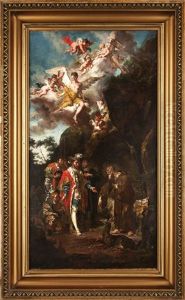Franz Anton Palko Paintings
Franz Anton Palko was an 18th-century painter who was born in 1724 in Bratislava, which was then part of the Kingdom of Hungary and is now the capital of Slovakia. He was a significant figure in Central European painting, although not as widely known as some of his contemporaries. Palko's work reflects the Baroque style, which was prevalent in European art from the early 17th century to the mid-18th century.
Palko came from a family of artists, which greatly influenced his career path. His father, Stefan Palko, was also a painter. Franz Anton received his early training from his father before moving to Vienna to further his education and professional development. Vienna, being a cultural hub at the time, allowed him to be exposed to the works of various prominent artists and to immerse himself in the artistic movements of the period.
Throughout his career, Palko specialized in religious themes and portraiture. His religious paintings often adorned the walls and altars of churches, reflecting the strong connection between the Baroque art movement and the Counter-Reformation efforts of the Catholic Church. These works are characterized by dramatic intensity, strong contrasts of light and shadow, and a sense of movement, which were all hallmarks of Baroque aesthetics.
As a portraitist, Palko was known for his ability to capture not only the likeness but also the character and social status of his subjects. His portraits are imbued with a sense of realism and attention to detail, which made them highly valued among the nobility and the bourgeoisie who wished to have their likenesses preserved for posterity.
Franz Anton Palko's career was relatively short, as he died at the age of 43 in 1767. Despite his early death, he left behind a body of work that continues to be studied and appreciated for its contribution to the Baroque movement in Central Europe. His paintings can be found in various museums, galleries, and churches, serving as a testament to his skill and artistic legacy.




